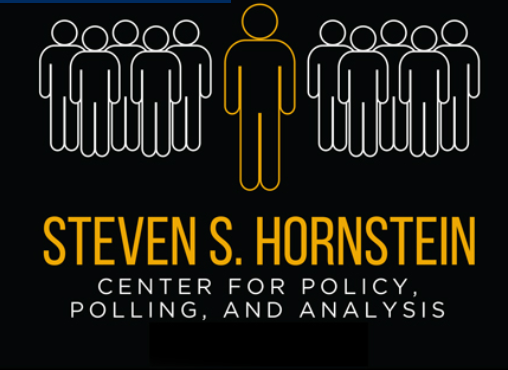Response to President’s Address Falls Along Party Lines
A new Long Island University Hornstein Center for Policy, Polling and Analysis poll showed that reactions to President Donald Trump’s first State of the Union address on Tuesday, January 30, were either favorable or unfavorable consistent with the party affiliation of those who watched.
But the national poll highlighted that many Americans are dis-engaged from party politics. Some 41 percent responded that they did not identify with one party over another, or did not engage in partisan politics. Nearly 40 percent did not watch Trump’s State of the Union address. Of those who watched the President’s speech, opinions are largely split down party lines, with 26 percent responding that they disapproved, while 28 percent found the speech “favorable” or “very favorable.” Only 27 percent reportedly believed that the Trump can deliver on his policy proposals, while more than 40 percent believed he could not. The poll consisted of slightly more Democrats (33 percent) than Republicans (22 percent), though an analysis of data shows that party identification played a large part in how respondents reacted.
What Americans polled by the Hornstein Center could agree on was that they felt dissatisfied with the current state of affairs in the United States. Nearly 55 percent did not believe the state of the union is strong, while only 20 percent agreed with President Tump’s assertion that it is. The majority of Americans believe that immigration, infrastructure and national security issues are of paramount importance to the state of the nation.
“It’s clear that while Americans are holding tightly to their ideological beliefs and view the President through the lens colored by their personal politics, they are also tired of the constant division,” said Dr. Edward Summers, Fellow at the Hornstein Center. “The President’s job, then, will be either the continued play to his tightly-held base or the appeal to Democrats in crafting policies that are less divisive to bring the nation together.”
The findings are based on a published public opinion poll conducted from January 30-31, 2018, of 1031 Americans.
Dr. Summers, who obtained his Ph.D. in Public Policy, is a Fellow at the Hornstein Center. His career includes experience in public policy, higher education, and opinion research.
Long Island University
Steven S. Hornstein Center for Policy, Polling, and Analysis
National Survey
January 30-31, 2018
| What is your reaction to President Trump’s State of the Union address? | ||||||
| Answer Choices | Responses | |||||
| Very Favorable; | 17.65% | 182 | ||||
| Somewhat Favorable; | 10.57% | 109 | ||||
| Somewhat Unfavorable; | 6.79% | 70 | ||||
| Very Unfavorable; | 19.01% | 196 | ||||
| No Opinion; | 7.27% | 75 | ||||
| I did not watch the address; | 38.70% | 399 | ||||
| Do you think President Trump can deliver on his proposed policies? | ||||||
| Answer Choices | Responses | |||||
| Yes; | 27.35% | 282 | ||||
| No; | 40.35% | 416 | ||||
| No Opinion; | 8.92% | 92 | ||||
| I did not watch the address; | 23.38% | 241 | ||||
| Were Democratic members of Congress who boycotted the address correct to do so? | ||||||
| Answer Choices | Responses | |||||
| Yes; | 30.55% | 315 | ||||
| No; | 37.63% | 388 | ||||
| Unsure; | 18.33% | 189 | ||||
| No Opinion; | 13.48% | 139 | ||||
| Do you believe that the state of the union is strong? | ||||||
| Answer Choices | Responses | |||||
| Yes, I am satisfied with the current state of affairs in the country; | 20.08% | 207 | ||||
| No, I am not satisfied with the current state of affairs in the country; | 54.80% | 565 | ||||
| Unsure; | 14.35% | 148 | ||||
| No Opinion; | 10.77% | 111 | ||||
|
|
||||||
| With what political party do you primarily identify? | ||||||
| Answer Choices | Responses | |||||
| I primarily identify with the Republican party; | 21.63% | 223 | ||||
| I primarily identify with the Democratic party; | 32.69% | 337 | ||||
| I primarily identify with another party; | 4.17% | 43 | ||||
| I do not primarily identify with one political party; | 28.23% | 291 | ||||
| I do not engage in partisan politics; | 13.29% | 137 | ||||
| Are you registered to vote? | ||||||
| Answer Choices | Responses | |||||
| Yes, I am registered to vote; | 89.14% | 919 | ||||
| No, I am not registered to vote; | 10.86% | 112 | ||||
| What do you believe to be the most important policy position discussed in the address? | ||||||
| Answer Choices | Responses | |||||
| Immigration; | 28.49% | 284 | ||||
| Infrastructure; | 21.26% | 212 | ||||
| National Security; | 19.76% | 197 | ||||
| Defense policy; | 5.02% | 50 | ||||
| Foreign policy; | 6.12% | 61 | ||||
| Tax reform; | 19.36% | 193 | ||||
| Age | ||||||
| Answer Choices | Responses | |||||
| 18-29 | 18.45% | 190 | ||||
| 30-44 | 27.28% | 281 | ||||
| 45-60 | 31.94% | 329 | ||||
| > 60 | 22.33% | 230 | ||||
| Gender | ||||||
| Answer Choices | Responses | |||||
| Male | 46.60% | 480 | ||||
| Female | 53.40% | 550 | ||||
| Household Income | ||||||
| Answer Choices | Responses | |||||
| $0-$9,999 | 8.74% | 90 | ||||
| $10,000-$24,999 | 11.07% | 114 | ||||
| $25,000-$49,999 | 17.86% | 184 | ||||
| $50,000-$74,999 | 14.76% | 152 | ||||
| $75,000-$99,999 | 11.55% | 119 | ||||
| $100,000-$124,999 | 9.13% | 94 | ||||
| $125,000-$149,999 | 5.44% | 56 | ||||
| $150,000-$174,999 | 2.82% | 29 | ||||
| $175,000-$199,999 | 1.84% | 19 | ||||
| $200,000+ | 4.76% | 49 | ||||
| Prefer not to answer | 12.04% | 124 | ||||
| Region | ||||||
| Answer Choices | Responses | |||||
| New England | 5.49% | 56 | ||||
| Middle Atlantic | 15.98% | 163 | ||||
| East North Central | 14.22% | 145 | ||||
| West North Central | 5.88% | 60 | ||||
| South Atlantic | 16.96% | 173 | ||||
| East South Central | 6.57% | 67 | ||||
| West South Central | 9.51% | 97 | ||||
| Mountain | 8.04% | 82 | ||||
| Pacific | 17.35% | 177 | ||||
Polling Methodology
This Long Island University Steven S. Hornstein Center for Policy, Polling & Analysis poll was conducted through Suveymomkey January 30-31, 2018 in English to 1031 Americans over the age of 18. Polling data was sorted by age, gender & geographic location in efforts to ensure a nationwide representative sample. This poll has an overall margin of error of +/- 3 points.
The Steven S. Hornstein Center for Policy, Polling, and Analysis at LIU Post conducts independent, fair, and balanced polling, empirical research, and analysis on a wide range of public issues including lifestyle preferences. The Center’s goals include informing the community, public and policy makers about critical issues.



